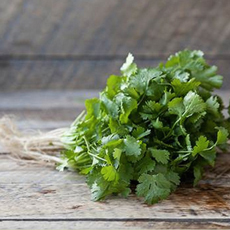TIP OF THE DAY: How To Chop Herbs

|
Fresh herbs are the avenue to adding a big punch of flavor with few calories to most dishes.
The emphasis is on fresh. While dried herb are a fine stand-by, they don’t deliver the same flavor—and the flavor fades as they age. First… THE DIFFERENCE BETWEEN HERBS & SPICES These two terms are often used interchangeably, but that’s inaccurate. There are important differences. Most herbs can be used in savory dishes. Think dill, garlic, thyme, oregano, parsley. In addition, there are the so-called sweet herbs, that can be used in both savory and sweet dishes: |
|
|
There are other sweet herb not often found in the U.S., such as sweet cicely (British myrrh). Stevia, an herb, delivers sweetness in addition to licorice notes. HOW TO CHOP FRESH HERBS Here’s what you should know before you grab a sharp chef’s knife and the cutting board: 1. Be sure the washed herbs are fully dry. If they’re just a bit damp, they’ll get mushy when you chop them. |
||
|
2. Herbs with edible stems. When you throw away the slender stems of herbs like cilantro, dill and parsley, you’re throwing away money. They are just as edible as the leaves. |
|
|
|
Big-leaf herbs like basil, mint and sage require a different technique. This group includes oregano, rosemary, tarragon and thyme. The leaves need to be stripped from the stems, but the stems are too woody to use. Chives, long and stem-free, are in their own category.
HOW TO STORE FRESH HERBS You don’t need an “herb keeper” to store herbs. Simply fill a tall glass with a few inches of fresh water, insert the herbs and cover with a plastic produce bag. It’s that easy!
|
||

